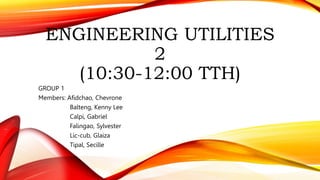The document discusses the basic principles of sanitary and plumbing design according to the 1999 National Plumbing Code of the Philippines. It outlines 22 principles that cover topics like ensuring a clean water supply, adequate water pressure, efficient water usage, preventing dangers from water heating devices, proper sewage disposal, and ventilation of plumbing fixtures. It also provides an overview of components of a plumbing system including pipes and fittings, plumbing fixtures, and the drainage system. Additionally, it discusses water sources like surface water and groundwater, as well as various water treatment methods.
















































































































































































































































